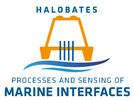Brandy Robinson
Research Interest
My research interests include the composition and accumulation of organic matter at the sea surface. Physiochemical and biological interactions in the sea surface and its relation to aerosols. The role of biofilms and the sea surface microlayer on air-sea interactions. Effects of breaking wave and resulting bubble plumes on sea surface microlayer dynamics and air-sea exchanges. Effects of bubble scavenging and bubble bursting on organic matter transport.
Current Project
My work is currently a part of the NorthSat-X project which focuses on the use of in-situ measurements of essential climate variables at the sea surface in order to support and validate satellite-based measurements. This involves the construction and optimization of an autonomous catamaran for sea surface microlayer and underlaying water sampling.
Education
PhD Environmental Sciences and Biodiversity (2016-2019)- Institute for Chemistry and Biology of the Marine Environment, University of Oldenburg. Thesis: Transparent exopolymer particles, from the ocean to the air and back again, an aggregates journey.
MRes Ocean Science (2011-2012)- National Oceanographic Centre, University of Southampton. Thesis: Diurnal Cycling of Hemoproteins in Marine Phytoplankton
B.S. Marine Biology (2007-2011)- Alaska Pacific University. Thesis: Prey Specialization of Enteroctopus Dofleini.
Articles
- Robinson, T. B., Wurl, O., Bahlmann, E., Jürgens, K., and Stolle, C. 2019. Rising bubbles enhance the gelatinous nature of the air–sea interface. Limnology and Oceanography. doi: 10.1002/lno.11188
- Robinson, T.B., Stolle, C. and Wurl, O., 2019. Depth is relative: the importance of depth for transparent exopolymer particles in the near-surface environment. Ocean Science, 15(6), pp.1653-1666. doi.org/10.5194/os-15-1653-2019
- Robinson, T. B., Giebel, H. A., Wurl, O. 2019. Riding the plumes: Characterizing bubble scavenging conditions for the enrichment of the sea-surface microlayer by transparent exopolymer particles. Atmosphere 10, no. 8 (2019): 454. doi.org/10.3390/atmos10080454
- Miranda, M.L., Mustaffa, N.I.H., Robinson, T.B., Stolle, C., Ribas-Ribas, M., Wurl, O., Zielinski, O., 2018. Influence of solar radiation on biogeochemical parameters and fluorescent dissolved organic matter (FDOM) in the sea surface microlayer of the southern coastal North Sea. Elementa: Science of the Anthropocene, 6 (1): 15. doi.org/10.1525/elementa.278.
- Xianda, G., Wex, H., M van Pinxteren., Triesch, N., Wadinga Fomba, K., Lubitz, J., Stolle, C., Robinson, T.B., Müller. T., Herrmann, H., Stratmann, F., 2020. Characterization of aerosol particles at Cape Verde close to sea and cloud level heights - Part 2: ice nucleating particles in air, cloud and seawater. Atmos. Chem. Phys. doi.org/10.5194/acp-20-1451-2020
- Pinxteren, M.V., Fomba, K.W., Triesch, N., Stolle, C., Wurl, O., Bahlmann, E., Gong, X., Voigtländer, J., Wex, H., Robinson, T.B. and Barthel, S., 2020. Marine organic matter in the remote environment of the Cape Verde islands–an introduction and overview to the MarParCloud campaign. Atmospheric Chemistry and Physics, 20(11), pp.6921-6951. doi.org/10.5194/acp-20-6921-2020
Teaching Experience
Summer semester 2020- Lecturer for “Introduction to Marine Chemistry” and “Seminar for marine and environmental chemistry”. University of Oldenburg
Winter semester 2020/21- Lecturer for “Seminar for sea surfaces” and “Practical course for marine interfaces”. University of Oldenburg
Summer semester 2021- Lecturer for “Introduction to Marine Chemistry” and “Seminar for marine and environmental chemistry”. University of Oldenburg
Cruises and Campaigns
2020 (2 weeks): Croatia, Adriatic Sea.
2019 (3 weeks): POS537, Mediterranean Sea.
2018 (2 months): MOCCHA18, Central Arctic.
2018 (3 weeks): EMB184, Baltic Sea.
2017 (1 month): MarParCloud, Cape Verde, Africa.
2017 (1 month): HE491, Trondheim and Sogne Fjords, Norway.
2017 (2 weeks): MILAN, Jade Bay, Germany.
2012 (1.5 months): JR271, High Arctic.

